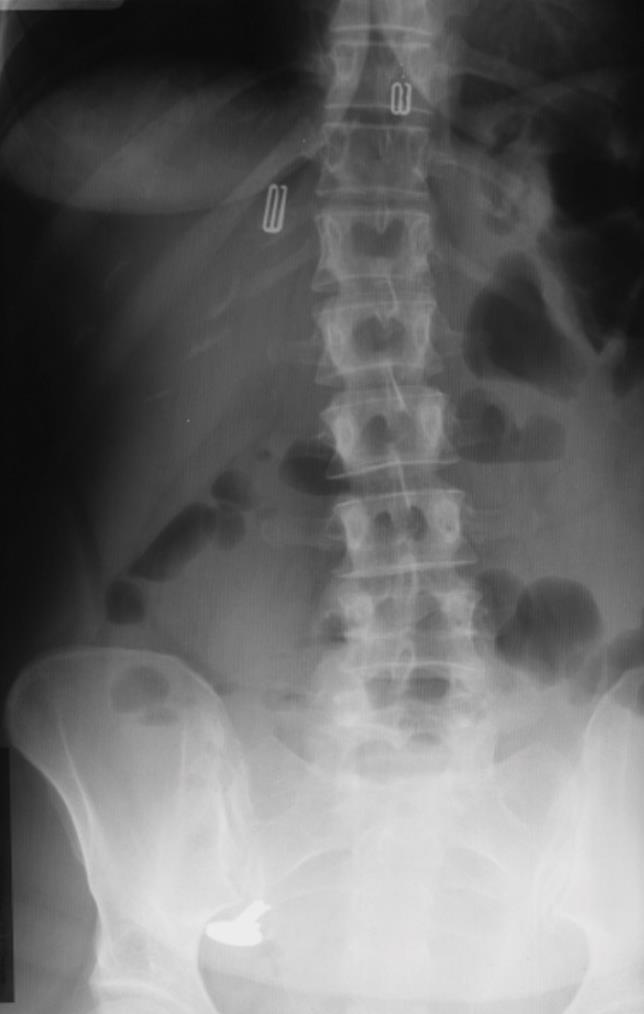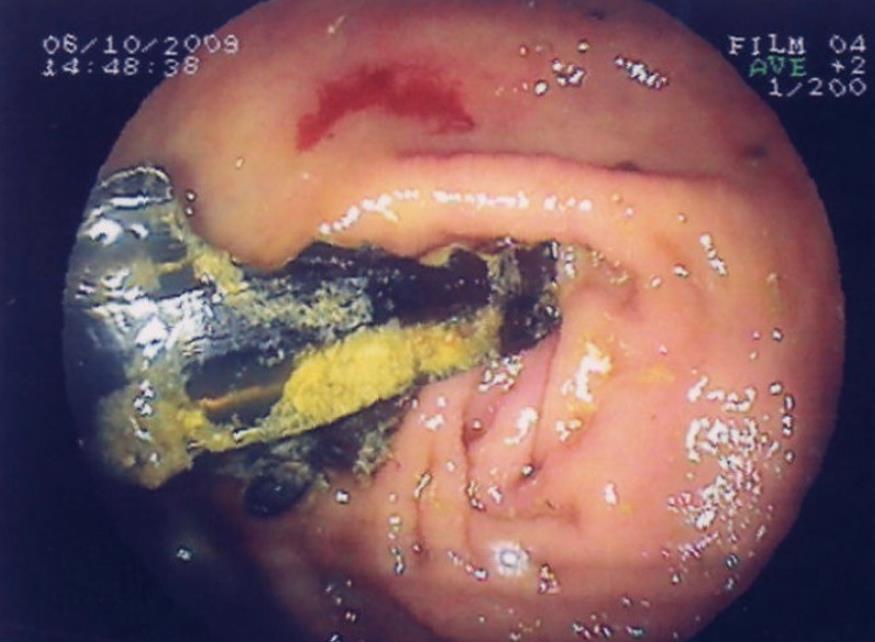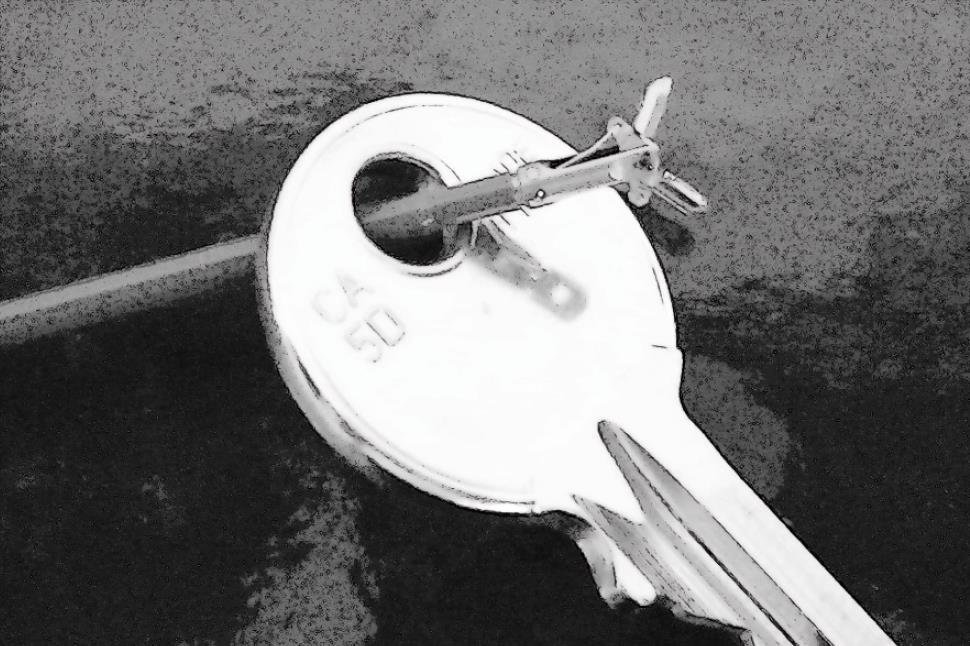Published online Nov 16, 2010. doi: 10.4253/wjge.v2.i11.372
Revised: October 26, 2010
Accepted: November 2, 2010
Published online: November 16, 2010
Ingested foreign bodies are rarely impacted in the appendix. They may be clinically latent or cause complications such as appendicitis or intestinal perforation, thus requiring prompt and appropriate therapy. A case is reported of a psychiatric, but in other respects asymptomatic, patient who presented with an ingested metal key deeply impacted within the appendix. The patient underwent urgent coloscopy for retrieval. Initially all conventional endoscopic instruments proved ineffective and the key was finally extracted using a simple manoeuvre, described herein.
- Citation: Pilichos C, Tasias G, Pyleris E, Anyfantis N, Pantelaros N, Barbatzas C. Endoscopic extraction of a metal key impacted within the appendix. World J Gastrointest Endosc 2010; 2(11): 372-374
- URL: https://www.wjgnet.com/1948-5190/full/v2/i11/372.htm
- DOI: https://dx.doi.org/10.4253/wjge.v2.i11.372
The passage of ingested foreign bodies through the gastrointestinal tract is uneventful in the great majority of cases. Complications, including bowel wall penetration, peritonitis or enteric obstruction, occur rarely. They are more frequent if the ingested objects are long and sharp such as chicken or fish bones, toothpicks and needles which tend to impact at sites of anatomical narrowing (pylorus, ligament of Treitz, ilio-cecal valve or recro-sigmoid junction). We report our experience with a patient presenting with an asymptomatic impaction of a metallic key within the appendix which was successfully managed by coloscopy.
A 44 year old woman was transferred from a psychiatric clinic to our hospital presenting with mild abdominal pain following the reported ingestion of a metal key 4 d previously.
The patient was in good clinical condition; all laboratory tests were normal. Abdominal x-rays confirmed the presence of the ingested key in the right iliac fossa (Figure 1).
Soon after her admission, the patient underwent urgent coloscopy without previous bowel preparation. The ingested object was found in the bottom of the cecum, deeply impacted in the appendix (Figure 2). Despite the use of conventional instruments for endoscopic foreign body extraction (polypectomy snare, alligator and rat tooth forceps, Dormia and Rothnet baskets), all attempts proved ineffective.
Finally we tried the following manipulation: we inserted a biopsy forceps through the hole in the handle of the key, kept the jaws of the forceps open using them as hooks and with gentle traction the impacted key was gradually moved in the cecum (Figure 3). The subsequent extraction through the anus was easily accomplished without complications.
Appendiceal impaction of an ingested foreign body is exceptional. It was described for the first time in 1759 and most cases were published before 1900, due to social habits such as hand sewing and wild game consumption. Depending on their shape and consistence, foreign bodies that impact in the appendix may cause appendicitis, abscess or intestinal perforation. Hydronephrosis and lead poisoning have also been reported[1-4]. Blunt foreign bodies such as keys and prosthetic teeth are likely to remain dormant for long periods and cause appendicitis through late obstruction of the appendiceal lumen. Thus, the object retrieval is indicated independently of clinical symptoms and time of diagnosis[4,5].
Traditionally, foreign body impaction in the lower gastrointestinal tract has been treated by early surgery. The appendix is no exception but this approach to management should be reconsidered as the technical equipment and skills of endoscopists have evolved[6,7]. Moreover, Selivanov et al[8] reporting a 10 year experience of 100 consecutive patients concluded that surgery might represent an overtreatment in this setting.
Colonoscopic removal of foreign bodies impacted in the appendix seems an efficacious and safe therapeutic method. According to a pragmatic algorithm recently proposed by Klingler, it should be attempted in patients without serious complications and for foreign objects radiographically localized in the right lower quadrant whose anatomical position seems unchanged during a three day follow-up. If this is unsuccessful however, laparoscopic exploration with fluoroscopic guidance should be carried out to localize and remove the objects either by ileotomy, colotomy or by appendectomy[9].
Peer reviewers: Kenneth Kak Yuen Wong, MD, PhD, Assistant Professor, Department of Surgery, The University of Hong Kong, Queen Mary Hospital, Pokfulam Road, Hong Kong, China; Varut Lohsiriwat, MD, Department of Surgery, Faculty of Medicine Siriraj Hospital, Mahidol University, Bangkok 10700, Thailand
S- Editor Zhang HN L- Editor Roemmele A E- Editor Liu N
| 2. | Meltzer SJ, Goldberg MD, Meltzer RM, Claps F. Appendiceal obstruction by a toothpick removed at colonoscopy. Am J Gastroenterol. 1986;81:1107-1108. |
| 3. | Klingler PJ, Smith SL, Abendstein BJ, Brenner E, Hinder RA. Management of ingested foreign bodies within the appendix: a case report with review of the literature. Am J Gastroenterol. 1997;92:2295-2298. |
| 4. | Reddy SK, Griffith GS, Goldstein JA, Stollman NH. Toothpick impaction with localized sigmoid perforation: successful colonoscopic management. Gastrointest Endosc. 1999;50:708-709. |
| 5. | Tanaka K, Toyoda H, Aoki M, Noda T, Aota T. An incarcerated prothetic tooth in the vermiform appendix. Gastrointest Endosc. 2007;66:400-401. |
| 7. | Chung YS, Chung YW, Moon SY, Yoon SM, Kim MJ, Kim KO, Park CH, Hahn T, Yoo KS, Park SH. Toothpick impaction with sigmoid colon pseudodiverticulum formation successfully treated with colonoscopy. World J Gastroenterol. 2008;14:948-950. |











